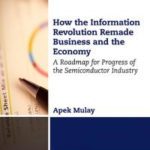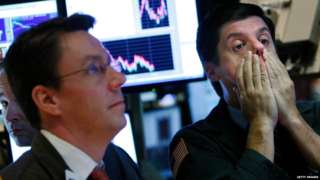This week, the United States Federal Reserve announced its first federal rate hike in nearly a decade. Although the increase was just 0.25%, it represents an important moment in the U.S. economy—and for the electronics industry.
In this blog, I’d like to review forecasts made in March 2015 and discuss what lies ahead for global semiconductor industry and global economy in light of these events. I predicted that:
1. Macroeconomic cycles of seven years, which have not been violated since 1980, will not be violated in 2015.
2. Starting July 2015, stock markets across the world will begin to fall and by October 2015 we will have an event like the Black Monday of 1987.
3. No matter how much the Fed delays hiking its benchmark interest rates, the macroeconomic cycles of nature cannot be controlled by the central banks.
4. The coming economic crash of 2015 will most likely be a complete collapse of crony capitalism.
Before we discuss above forecasts, let me make a few points very clear. First, I am not a trained macroeconomist by education. I am an engineer with a Master of Science (MS) degree in Electrical Engineering with a specialization in semiconductor processing and device physics. Second, macroeconomics has become my passion. I was very much impressed with accurate economic forecasts (greater than 95%) and sterling record of publications of world famous economist, Professor Ravi Batra of Southern Methodist University in Dallas.
Since 2007, I’ve independently studied this field to understand the ins and outs of macroeconomics with an eye toward making the field of microelectronics sustainable and profitable. Both of my books have focused on this.
Now, let’s look at where the global economy stands from the point of view of my forecasts.
1. The Chinese stock market crash began with the popping of the stock market bubble on 12th June 2015. A-shares on the Shanghai Stock Exchange lost one-third of their value within a month of the event. The impacts of the crash of the stock market of this world economy were felt across the global economy. The crash of China was the biggest economic crash of 2015. The seven-year macroeconomic cycle, begun in 1980, has held.
2. Major aftershocks from the China’s stock market crash were felt across the global economy. Money magazine estimated that the potential negative impact on the United States stock market may come about when Chinese investors begin to seek out relatively stable U.S. investments in treasuries, stocks, and cash. These shifts strengthened an already-strong U.S. dollar, raising the prices on U.S. goods and diminishing export profits. Global companies that relied on the Chinese market suffered from the crash. Stocks that they own were devalued US$4 trillion. On 24 August, Shanghai main share index lost 8.49% of its value. As a result, billions of pounds were lost on international stock markets with some international commentators labeling the day “Black Monday.” As predicted, we have a new Black Monday. Here some of my thoughts from a recent panel in the video below.
3. My predictions of an economic depression in the U.S. in 2015 were based on an economic trajectory. This economic collapse hinged on the lack of free market reforms based on mass capitalism in obht the U.S. and global economies. In Mass Capitalism: A Blueprint for Economic Revival, I wrote:”As the Fed starts cutting back on its QE, the US government will not be able to lure Americans into borrowing more to keep sustaining the domestic economy like before. ”
In that volume, I also predicted that the U.S. Federal Reserve would end its eighty-five-billion-dollars-per-month bond-buying program, which it did in October 2014. That move did not raise raised the bench mark interest rates from 0%. The rate hike did not come in June 2015, as anticipated, but rather was moved to September, then further delayed until now. Given the inconsistency of the Fed in its decision to hike interest rates, the timeline for my forecasts about an economic collapse also have been delayed.
In March 2015, I was interviewed by an Indian television station and said “My analysis is that the crisis will start from developing countries and eventually it would strike the United States.” In my second book, I also explored what is to be done when there is a flight of capital from developing countries like India and China to U.S. when the rate hike ultimately occurred. Recently, Foreign investors pulled out over $1.5 billion from India’s capital markets in November 2015. China also saw a record capital outflows in November 2015. All of these recent events point to a crisis brewing in developing economies as a result of flight of capital.
This flight strengthens the U.S. dollar and further crushes the prices of commodities including gold, copper, oil, iron ore and others. That downfall was begun as a result of oversupply caused by monopolies.
Now, there is a rising risk of deflation in U.S. economy even as the flight of capital from developing countries causes a depreciation of those currencies and a rise in inflation in developing economies. Under such circumstances, the “Make In India” initiative of India is really at a risk of failing.
As a result of the rising US dollar, U.S. exports are going to decrease. However, the countries’ imports and trade deficits will continue to build. A strong dollar and lack of free markets in U.S., as well as the high value of US dollar, will eventually result in a credit crunch. This would crash the corporate profits. Meanwhile, stock markets are bound to crash due to a rising dollar. Crashing oil prices will result in major bankruptcies of shale oil producers in United States. Similarly, increasing mergers and acquisitions in the high tech sector will not to stop the erosion of profits of electronics manufacturers as well. All of this points to a looming, long-term depression.
I continue to believe that we need a free market economy in United States where market forces, rather than politicians and bankers, control supply and demand. Rajani Kanth, visiting fellow at Harvard University, in the foreword of Mass Capitalism: A Blueprint for Economic Revival writes Mass Capitalism offers one such free market economic solution for the revival of global high tech industry so that wages automatically catch up with productivity with a minimal government intervention. Professor Ravi Batra in the foreword of Sustaining Moore’s Law put it this way:
…experts fear that a well-known rule of economics, the law of diminishing returns, will soon come into play and lower the return on investments linked to the upholding of Moore’s law. In the present work, the author shows how this can be avoided through proper economic policy. This is because in general the return on any kind of investment depends on the health of the macro economy, or the basic forces of supply and demand. If a nation’s total production is in balance with total demand, goods produced by industries have a ready market and an adequate profit. However, if supply exceeds demand, there is overproduction that leads to a recession and layoffs. In that milieu, the return on investment becomes mediocre and may even be negative. All this only means that proper macroeconomic policy is needed to ensure the profitability of any project.
Let us know what you think of recent economic happens and how it will affect the electronics industry in the comments section below.


Recent Comments